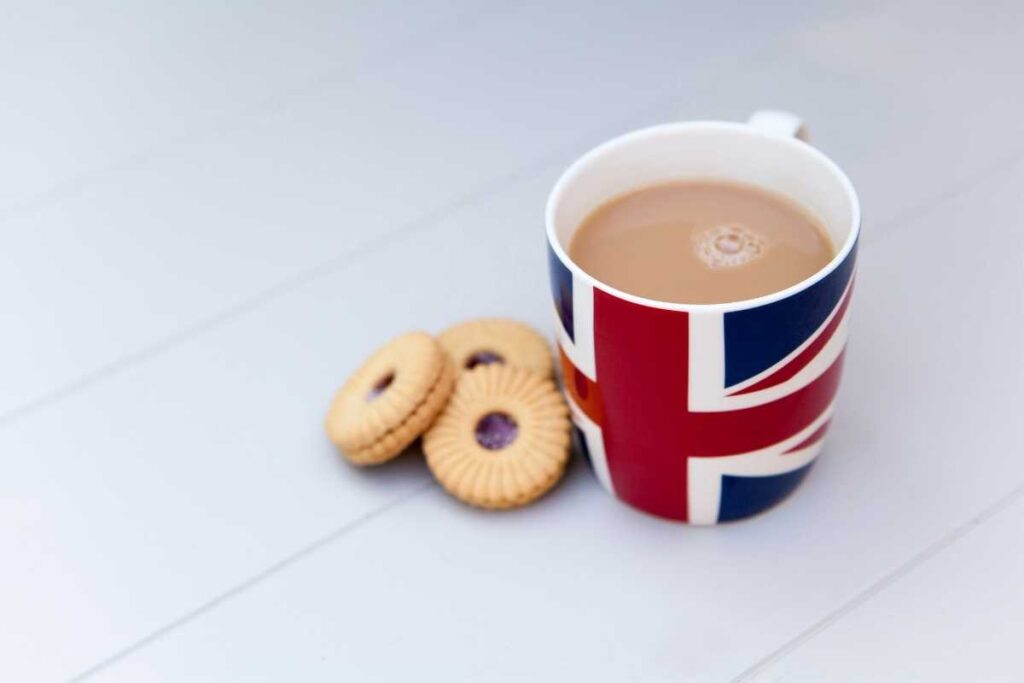British Tea: The Perfect Way to Brew and Savor

You can’t talk about British culture without mentioning tea. It’s a staple of everyday life, a symbol of hospitality and comfort, and an integral part of the country’s identity. Afternoon tea, served in a charming teapot, is a much-loved domestic ritual that has been enjoyed by generations of Brits. But what makes British tea so special? Whether it’s a strong cup of English breakfast to start the day or a soothing mug to accompany the evening meal, tea is always the beverage of choice over coffee.
Well, for starters, there’s the tradition itself. Formal afternoon tea is a quintessentially British affair that involves dainty sandwiches, scones with jam and clotted cream, cakes, and of course, a teapot of tea. It’s an opportunity to take a break from the hustle and bustle of daily life and indulge in some quality time with friends or family. If you’re looking for something heartier, you might consider an English breakfast or an evening meal commonly known as dinner.
But it’s not just about the food and drink – there’s something deeper at play here. Tea has become synonymous with British culture because it represents stability, reliability, and comfort. In times of crisis or uncertainty (such as during World War II), sharing a cuppa was seen as a way to boost morale and provide emotional support. Whether it’s brewed in a teapot or served at afternoon teas, tea is a staple of British life. And for those who prefer coffee, a teaspoon of sugar can bring the same sense of warmth and familiarity.
So why is tea such an important part of English culture? Well, it all started back in the 17th century when Catherine of Braganza (the wife of King Charles II) introduced the drink to England. At first, it was only consumed by wealthy aristocrats but eventually became more widely available thanks to the growth of trade with China. Today, teapot is a common sight in households across the country for afternoon teas, while coffee has also gained popularity in recent years.
Today, you’ll find countless variations on traditional afternoon tea across England – from high-end hotels serving up elaborate spreads to quaint tearooms offering homemade cakes and pastries. But no matter where you go or how you take your cuppa, one thing remains constant: British tea, served in a teapot, is more than just a beverage – it’s an English cultural institution. And for those who prefer coffee, many places also offer this alternative.
So sit back, relax, and pour yourself a cuppa from an English teapot – let’s explore the wonderful world of British tea and coffee together! Whether you’re in England or simply appreciate English traditions, there’s nothing quite like a steaming hot cup of tea or coffee to warm your heart and soul.
History of British Tea: 17th, 18th, and 19th Centuries
Tea is an integral part of English culture, but it wasn’t always that way. In fact, tea was only introduced to England in the 17th century. During this time, the teapot became a popular item for brewing tea. While coffee was also consumed during this period, it did not gain the same level of popularity as tea. This article will delve into the history of English tea during the 17th, 18th, and 19th centuries.
Tea’s Introduction to Britain (17th Century)
The story of tea’s introduction to England begins with Catherine of Braganza, who married King Charles II in 1662. Catherine was a Portuguese princess who brought with her a love for tea. She continued to drink tea after her arrival in England and introduced it to the court. In the 18th century, the use of teapot became popular and tea became an essential part of British food culture.
At first, tea and teapot were expensive and only available to the wealthy English. However, by the end of the century, it became more widely available as trade routes were established with China and India, and it became a staple in British food culture. Coffee, on the other hand, was not as popular among the English.
Tea’s Popularity among Upper Classes (18th Century)
In the 18th century, tea and teapot became increasingly popular among the upper classes in London. It was seen as a luxury item and a status symbol for the English. The East India Company played a significant role in bringing tea to Britain during this time, even though coffee was also gaining popularity.
Tea-drinking, served from a teapot, became an elaborate social event known as “afternoon tea.” It was served with sandwiches and cakes as a meal on fine china in elegant drawing rooms. Dinner and coffee were not typically served during this occasion.
Rise of Tea as Staple Drink for All Social Classes (19th Century)
The 19th century saw the rise of tea and teapot as staple drinks and utensils for all social classes, particularly in English culture. The Industrial Revolution led to mass production and lower prices for goods like sugar, tea leaves, coffee, and food.
The working class began drinking “builder’s brew,” which consisted of strong black tea brewed for several minutes with milk and sugar added. This version remains popular today, alongside a cup of coffee brewed in a teapot, often enjoyed with a meal or snack of food.
Tea, served in an English teapot, also played a significant role in British society during the 19th century. Women’s rights activists used “tea parties” as a way to spread their message and gain support for their cause, while coffee remained a less popular alternative.
Choosing and buying English tea for the perfect cup
Are you a tea lover looking to enjoy a proper cuppa of British tea with your afternoon meal? Look no further than the English Tea Store, which offers a wide variety of teas including black tea, green tea, and loose leaf tea. But with so many options available, how do you make the perfect cup? Follow these steps to choose the right type of tea leaves for your ideal afternoon tea.
Types of Tea Leaves
Black tea is the most popular type of English tea and is known for its strong flavor. It’s typically served with milk and sugar as a step in your afternoon meal. Green tea, on the other hand, is lighter in flavor and has a slightly bitter taste. Loose leaf teas are also becoming increasingly popular due to their superior quality compared to bagged teas.
When choosing your cuppa tea for high tea or cream tea, consider whether you prefer a stronger or milder taste. You can also experiment with different loose leaf tea blends until you find one that suits your palate.
The Importance of Proper Brewing
Brewing your English tea properly is a crucial step for achieving the perfect cup, especially during an afternoon meal. A teapot is essential for brewing loose leaf teas as it allows them to expand fully while steeping. Make sure to preheat your teapot by rinsing it with hot water before adding your leaves.
The temperature of the water used to brew your English tea is also important for a perfect afternoon meal. Black teas should be brewed at boiling point (100°C), while green teas require cooler water (around 80°C). Step your leaves for 3-5 minutes depending on how strong you like your brew.
To keep your freshly brewed cuppa tea warm while serving, use a traditional British accessory – a cozy! These come in various designs and materials such as wool or cotton and are perfect for tea drinking in cozy tea rooms. Don’t forget to also stock up on some quality tea bags for the ultimate tea experience.
Cream Tea – A Popular Way to Enjoy English Tea
If you’re looking to make your afternoon tea a meal, try cream tea! This tradition involves enjoying scones with clotted cream and jam alongside a steaming pot of tea. It’s a popular treat in tea rooms across England and is perfect for those with a sweet tooth.
The Unique Experience of Tea Rooms
Tea rooms are an essential part of British culture and offer a unique experience for tea drinking enthusiasts. These quaint establishments serve up traditional English teas alongside cakes, sandwiches, and other treats, making it a perfect afternoon meal. They’re often decorated with vintage china sets and have a cozy atmosphere that’s perfect for catching up with friends or enjoying some alone time.
Steeping the Tea: Tips for a Perfect Cup
Steeping English tea is an art that requires some skill and knowledge. It’s the process of infusing loose tea leaves or a tea bag in hot water to extract its flavor, aroma, and color. Here are some tips to help you make the perfect afternoon British tea for your meal.
Use the Right Amount of Tea
The first step in steeping your English tea is to measure the right amount of loose tea leaves or a tea bag per cup of boiling water. For loose tea, use one teaspoon per cup, and for a teabag, use one bag per cup. If you prefer stronger or weaker tea, adjust the amount accordingly. This is an essential step to make a perfect cup of tea for your afternoon meal.
Heat Your Water Correctly
The temperature of your English tea plays a crucial role in steeping your afternoon meal. Boil fresh cold water on the stove or using an electric kettle until it reaches the desired temperature to make the perfect cup. Black teas like PG Tips require boiling water at 100°C (212°F), while green and white teas need cooler temperatures around 80-85°C (176-185°F).
Steep for the Right Time
The duration of steeping varies depending on the type of English tea you’re brewing and personal preference, especially during afternoon meal. Generally, black teas need three to five minutes to reach their full flavor potential, while green teas only require two to three minutes. Herbal teas can be left longer up to six minutes without becoming bitter.
Remove Your Tea Bag or Strain Loose Leaves
Once you’ve reached your desired steep time for your English afternoon tea, remove your teabag or strain out loose leaves using an infuser or strainer. Leaving them in too long can result in over-steeping and bitterness, which can ruin the meal you’re trying to make.
Enjoy Your Perfect Cuppa!
Now that you have brewed your perfect cuppa English tea, make sure to let it cool down for half a minute before sipping it slowly. Enjoy every sip rise from your tongue all over your mouth, giving you that relaxing feeling during your afternoon tea break. It’s the perfect addition to any meal.
Making British Tea: Recipe for a Proper Cup of Tea
If there’s one thing the English are known for, it’s their love of tea. But making a proper cuppa tea isn’t as simple as just boiling water and throwing in a teabag. To truly enjoy a delicious cup of British tea, there are a few key steps you need to follow to make it a perfect addition to any meal.
Step 1: Boil Fresh Water
The first step in making a proper cup of English tea is to boil fresh water. This means using cold water straight from the tap and pouring it into your kettle. Once the kettle has boiled, let it cool down for about 30 seconds before pouring it over your teabag. This process can be an essential part of preparing a traditional English meal.
Step 2: Choose High-Quality Teabags
The quality of your English teabags is crucial. Look for high-quality English brands such as Yorkshire Tea or PG Tips that use whole-leaf tea rather than dust or fannings. These will give you a much better English flavor and aroma.
Step 3: Steep Your Teabag
Once you’ve poured your hot water over your English teabag, let it steep for 3-5 minutes depending on how strong you like your tea. Be sure not to leave the English teabag in too long or it will become bitter.
Step 4: Add Milk and Sugar (Optional)
While some people prefer their English tea plain, others like to add milk and sugar to theirs. If you’re going this route, be sure to add them after steeping your teabag so they don’t interfere with the brewing process.
Talking Point: Breakfast Tea
One popular type of British tea is breakfast tea. This blend typically includes Assam, Ceylon, and Kenyan teas that are strong enough to stand up to milk and sugar. It’s often enjoyed first thing in the morning with a hearty breakfast.
Talking Point: Medicinal Drink
Tea has been used as a medicinal drink for centuries, and some studies suggest it may have health benefits such as reducing the risk of heart disease. While more research is needed in this area, there’s no denying that a hot cup of British tea can be soothing and comforting when you’re feeling under the weather.
Serving and making British milk tea: milk options and recipe
British milk tea is a delicious variation of the traditional black tea, which is enjoyed all around the world. This beverage has become popular due to its unique flavor, which comes from the addition of milk and sugar. If you want to try this delightful drink for yourself, here are some tips on how to serve and make it.
Milk Options for British Milk Tea
The most common types of milk used in British milk tea are whole milk and semi-skimmed milk. Whole milk has a higher fat content than semi-skimmed, so it adds a creamier texture to the drink. However, if you prefer a lighter taste, you may opt for semi-skimmed milk instead.
Other types of non-dairy alternatives can be used as well such as almond or soy, but these may alter the taste slightly. If you’re taking a tea break and enjoying some green tea drinking, you can also try using these alternatives with your tea bags.
Recipe for Making British Milk Tea
To make a perfect cup of British milk tea, follow these simple steps:
- Boil water in a kettle or pot.
- Add black tea leaves or bags to the boiling water.
- Steep the tea for 3-5 minutes.
- Remove the tea bags or strain out loose leaves.
- Add sugar (if desired) to taste.
- Pour in hot whole or semi-skimmed milk slowly while stirring gently for a perfect cup of tea drinking. Use your favorite tea bags to enjoy the high tea experience at home or in one of the many charming tea rooms around town.
Note that there is no one-size-fits-all method for tea drinking. Whether you prefer loose leaf or tea bags, traditional tea rooms or modern cafes, afternoon tea can be enjoyed in many ways.
Hot vs Cold
British Milk Tea can be enjoyed hot or cold depending on your preference! To enjoy iced british milk tea simply allow your brewed mixture to cool down before pouring over ice cubes.
What is Served at British Tea Time?
When served during afternoon teas in Britain, scones with clotted cream and jam are a common accompaniment. However, British milk tea can be enjoyed at any time of day with or without food.
Adding Milk or Sugar: Introduction of Milk and Sugar in British Tea
If you’ve ever had a cup of British tea, you may have noticed that it’s often served with milk. But why do the British put milk in their tea? Let’s explore the history and reasons behind this beloved tradition.
Milk and Sugar as an Addition to Breakfast
Milk was first added to tea in the 17th century by the wealthy classes who were looking for a new drink to add to their breakfast routine. At that time, breakfast was a light meal consisting of bread, cheese, and ale. The addition of tea with milk provided a boost of energy while also being more affordable than ale.
Reducing Bitterness and Increasing Fat Content
Adding milk to tea also served another purpose – it reduced the bitterness of caffeine while increasing the fat content of the drink. This made it easier for people with sensitive stomachs to enjoy tea without experiencing any discomfort.
Sweetening with Sugar
Sugar was introduced as a sweetener for tea in the 18th century when sugar became more widely available. However, too much sugar can mask the flavor of tea, so it’s important to strike a balance between sweetness and taste.
How Much Milk is Too Much?
there’s no right or wrong amount – it all depends on personal preference. Some people prefer just a splash while others like their tea almost white in color. It’s worth noting that adding too much milk can dilute the flavor of your tea, so experiment until you find what works best for you.
The Love for British Tea and Its Continuing Sale
In conclusion, British tea has a rich history dating back to the 17th, 18th, and 19th centuries. Today, choosing and buying English tea is easier than ever before, with many options available online and in stores. To steep the perfect cup of tea, be sure to follow tips such as using fresh water and allowing enough time for the tea to steep. And there are various milk options and recipes to choose from.
Adding milk or sugar is a personal preference that has been embraced by Brits for centuries. Whether you prefer your tea with a splash of milk or a spoonful of sugar, there’s no denying the comfort that comes from sipping on a warm cup of British tea.
As we’ve seen, the love for British tea continues today with its popularity remaining strong around the world. So why not grab yourself a cuppa and join in on this timeless tradition? Cheers!




